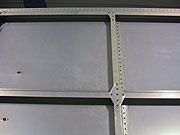Photos of Two Minor Debris Impacts Leonardo MPLM Suffered on its Inaugural Mission
These photos show micrometeoroid damage to a micrometeoroid/orbital debris (MMOD) shield panel from MPLM FM1 (Leonardo). The panel was penetrated in two spots (the small pinholes in the photos), but did not damage the multi-layer insulating blanket beneath. This module was in space for about a week. The strike damage to Leonardo’s MDPS (micrometeorite protection system) is characteristic of other impacts that have been seen on spacecraft. However, the size of particle that penetrated the shield was a bit larger than average and was estimated to be traveling rather fast – at least 10 kilometers/second – when it struck Leonardo. To put this impact into perspective, had this piece of space debris hit a Space Shuttle window it would have left a crater approximately 1 inch (2.5 cm) in diameter. If it had hit a someone wearing an EVA spacesuit it would have gone partially through the suit and left a bruise on the person wearing the suit. Impacts such as these two are routine for any spacecraft in Earth orbit. The Long Duration Exposure Facility (LDEF) which spent 5.7 years in Earth orbit had been struck more than 20,000 times by the time its was brought back to Earth. The Hubble Space Telescope had nearly 800 impacts by the time it was repaired in 1997. How much debris a spacecraft can expect to collide with – the orbital debris flux – is a function of mission duration, the size and orientation of the spacecraft (how big of a target it is), the orbital inclination, altitude, and the level of solar activity. Components of the International Space Station are provided with shielding so as to reduce the annual risk that impact with a space debris could cause a critical failure to less than 0.5% This shielding is also sized to last through the expected 15 year operational lifetime of the ISS. Last year, it was discovered that the Service Module did not have sufficient shielding to meet requirements levied upon it by the ISS program. As such, additional shielding panels will be delivered and installed on the exterior of the Service Module. These pictures were taken of the Leonardo MPLM (Multi-Purpose Logistics Module) at NASA KSC after it returned to Earth from its first mission. Leonardo is one of three MPLM’s provided by Italy and was flown to the International Space Station last month on mission STS-102/ISS-5A.1.
These pictures were taken of the Leonardo MPLM (Multi-Purpose Logistics Module) at NASA KSC after it returned to Earth from its first mission. Leonardo is one of three MPLM’s provided by Italy and was flown to the International Space Station last month on mission STS-102/ISS-5A.1.

Related links














